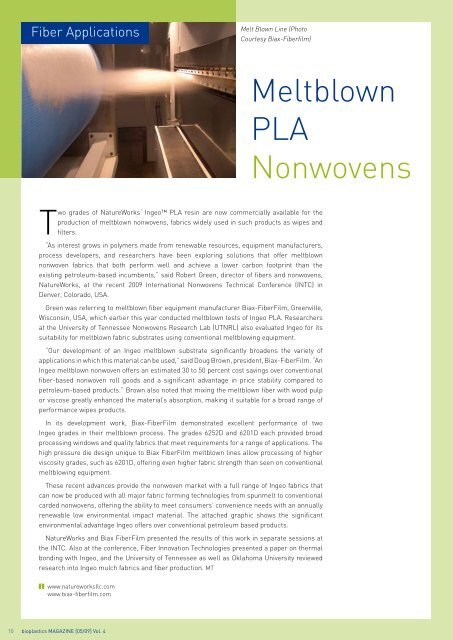bioplasticsMAGAZINE_0905
bioplasticsMAGAZINE_0905
bioplasticsMAGAZINE_0905
You also want an ePaper? Increase the reach of your titles
YUMPU automatically turns print PDFs into web optimized ePapers that Google loves.
Fiber Applications<br />
Melt Blown Line (Photo<br />
Courtesy Biax-Fiberfilm)<br />
Meltblown<br />
PLA<br />
Nonwovens<br />
Two grades of NatureWorks‘ Ingeo PLA resin are now commercially available for the<br />
production of meltblown nonwovens, fabrics widely used in such products as wipes and<br />
filters.<br />
“As interest grows in polymers made from renewable resources, equipment manufacturers,<br />
process developers, and researchers have been exploring solutions that offer meltblown<br />
nonwoven fabrics that both perform well and achieve a lower carbon footprint than the<br />
existing petroleum-based incumbents,” said Robert Green, director of fibers and nonwovens,<br />
NatureWorks, at the recent 2009 International Nonwovens Technical Conference (INTC) in<br />
Denver, Colorado, USA.<br />
Green was referring to meltblown fiber equipment manufacturer Biax-FiberFilm, Greenville,<br />
Wisconsin, USA, which earlier this year conducted meltblown tests of Ingeo PLA. Researchers<br />
at the University of Tennessee Nonwovens Research Lab (UTNRL) also evaluated Ingeo for its<br />
suitability for meltblown fabric substrates using conventional meltblowing equipment.<br />
“Our development of an Ingeo meltblown substrate significantly broadens the variety of<br />
applications in which this material can be used,” said Doug Brown, president, Biax-FiberFilm. “An<br />
Ingeo meltblown nonwoven offers an estimated 30 to 50 percent cost savings over conventional<br />
fiber-based nonwoven roll goods and a significant advantage in price stability compared to<br />
petroleum-based products.” Brown also noted that mixing the meltblown fiber with wood pulp<br />
or viscose greatly enhanced the material’s absorption, making it suitable for a broad range of<br />
performance wipes products.<br />
In its development work, Biax-FiberFilm demonstrated excellent performance of two<br />
Ingeo grades in their meltblown process. The grades 6252D and 6201D each provided broad<br />
processing windows and quality fabrics that meet requirements for a range of applications. The<br />
high pressure die design unique to Biax FiberFilm meltblown lines allow processing of higher<br />
viscosity grades, such as 6201D, offering even higher fabric strength than seen on conventional<br />
meltblowing equipment.<br />
These recent advances provide the nonwoven market with a full range of Ingeo fabrics that<br />
can now be produced with all major fabric forming technologies from spunmelt to conventional<br />
carded nonwovens, offering the ability to meet consumers’ convenience needs with an annually<br />
renewable low environmental impact material. The attached graphic shows the significant<br />
environmental advantage Ingeo offers over conventional petroleum based products.<br />
NatureWorks and Biax FiberFilm presented the results of this work in separate sessions at<br />
the INTC. Also at the conference, Fiber Innovation Technologies presented a paper on thermal<br />
bonding with Ingeo, and the University of Tennessee as well as Oklahoma University reviewed<br />
research into Ingeo mulch fabrics and fiber production. MT<br />
www.natureworksllc.com<br />
www.biax-fiberfilm.com<br />
10 bioplastics MAGAZINE [05/09] Vol. 4


















